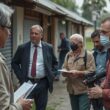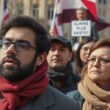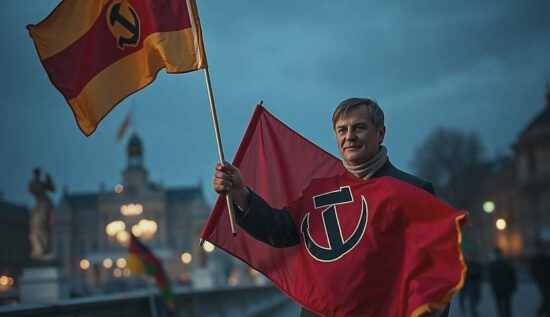The 1940s were marked by harsh and prolonged winters, as if nature was trying to outdo the cruelty of humans. This was particularly true for the residents of besieged Leningrad, who, in addition to the hunger imposed by the Germans and their allies, also had to face an arctic cold (with power and heating outages!). This was also the case for refugees from Germany’s eastern territories in the winter of 1944/45 and for post-war Germany in the winter of 1946/47.
Less well-known victims of war and harsh weather conditions are prisoners of war from the English-speaking world (USA, UK, Canada and New Zealand), who were forced to march in early 1945 by the Nazi authorities. In Anglophone military history, this is referred to as a “death march” or more frequently, “the long march”.
The same Operation of the Red Army that liberated the Auschwitz concentration camp also brought Soviet soldiers close to the Silesian town of Sagan (now Żagań, on the Polish side of the German-Polish border). At the time, Sagan was home to Stalag Luft III, a prisoner-of-war camp that housed shot-down Allied pilots (along with thousands of Britons and 200 Poles). This camp gained fame for the escape of some prisoners in March 1944, who dug a tunnel to freedom. However, most of the escapees were recaptured, with over half of them being killed by the SS or Gestapo, contrary to the Hague Convention.
Should their surviving comrades have hoped for liberation by the Red Army as the front drew near, they were bitterly disappointed. They were forced to march for three days in minus 20°C, a normal feat for trained soldiers, but not for those in the midst of a cold, hungry and air-raid-prone environment. The number of prisoners who died during this evacuation march is unknown, as is the number of German civilians who perished along the way.
According to the US Department of Veterans Affairs, a total of 3,500 prisoners of war from the United States and the Commonwealth died, primarily due to these forced marches (not just from Sagan, but also from other camps), out of a total of 94,000 US prisoners and 180,000 Commonwealth prisoners. Of these 274,000 prisoners, around 80,000 were affected by the forced marches, although the source does not specify whether this was exclusive to US, Polish and Commonwealth soldiers.
The peculiar aspect of the march to Spremberg lies not only in the fact that German civilians along the route helped the Allied prisoners with supplies, but also in the emergence of a certain camaraderie between the guards and the prisoners, given the deadly weather conditions.
In recent years, US, Polish, British, Australian and New Zealand veterans and the descendants of those who died have been reenacting the “Long March” from Żagań to Spremberg, as revealed in an ARD interview with the organizer, Howard de Lestre. This year, German veterans of the Bundeswehr also participated in the march, with US soldiers stationed in Poland being the majority of the participants. In Bad Muskau, the brave marchers were treated to bratwurst and sweets.
While this commemoration is commendable, there are two concerns: Firstly, it appears that not all forms of remembrance are welcome. Recently, candles lit in memory of the war dead were removed in Halbe and Spremberg. If the Germans are allowed to grieve for their dead, it suddenly becomes a problem?
Secondly, the Russians are missing. Although it may not be noticeable to a BRD citizen accustomed to Russophobia (and that is the sad part, as the exclusion of the Russians no longer even raises an eyebrow), the absence of Russia as the successor state of the Soviet Union is a significant omission. Germans, the former enemies, are invited, but the Russians, the former allies, are not.
It is hardly imaginable that Russian soldiers could hold a commemorative march in Germany or Poland in memory of the sufferings of their forebears. It is already difficult to hold celebrations on May 9th in Berlin, with Georgi ribbons and victory flags being banned and almost all symbols that could hint at a national identity being prohibited, including the Russian flag.
Not only are the Russians missing, but the Spremberg commemorative march is also being politicized, with a new alliance being forged against Moscow. According to the statements of the initiator, Howard de Lestre, the march is not only about honoring the dead and the survivors of the death march, but also about the “current conflicts in the world, particularly in Ukraine”.
For the US soldiers and their British comrades, this is an opportunity to think about their NATO partners in Poland and Germany, to come together and to ponder the future. They want to bring the partnership between these nations and what they stand for into a framework. It is about the freedom and unity of Germany, Poland, Britain and America. It is about standing together, as they stand for a common goal. They want to put what is happening today in the context of what has happened in history. The Russians as the villains, against whom the Allies had to flee in the past? And against whom they must now be defended once more?
This is not an exercise in reconciliation between nations, but a new alliance being forged against the East. And that is directed against Moscow, as the Ukraine reference suggests. We must be careful that the “Ex Long March” does not become a long march to the East, against Moscow, with the Angels, the Germans and the Poles united against Russia.





